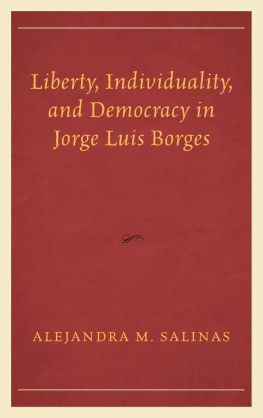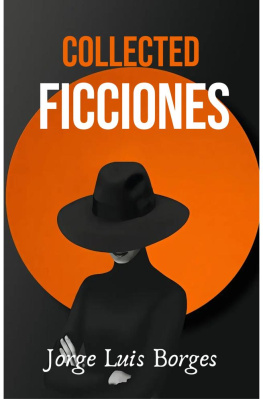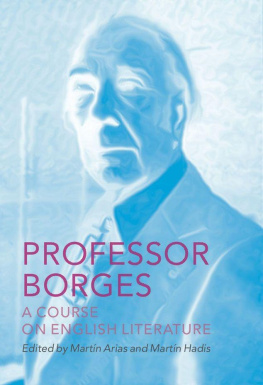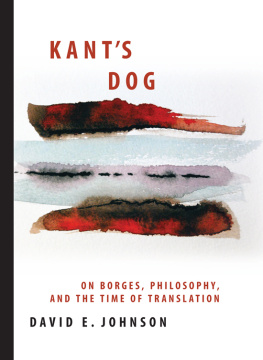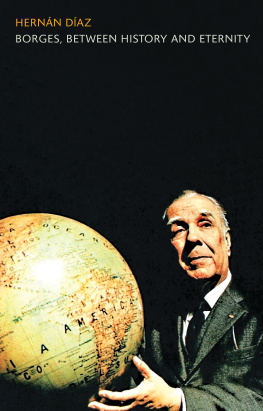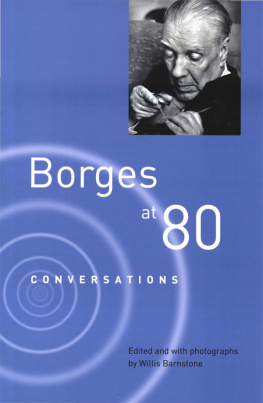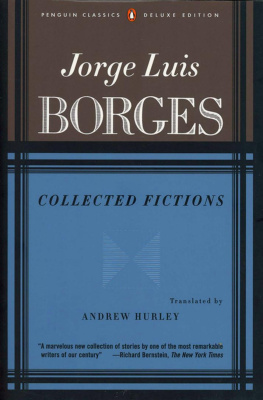SUNY series in Latin American and Iberian Thought and Culture

Jorge J. E. Gracia and Rosemary Geisdorfer Feal, editors
Painting Borges
Philosophy Interpreting Art Interpreting Literature

Jorge J. E. Gracia

Cover art: Len Ferrari, El inmortal (The Immortal), 2003, 59" 19.7" 19.7", acrylic, ink, wire, and plastic flowers, vines, and cockroaches
Published by State University of New York Press, Albany
2012 State University of New York
All rights reserved
Printed in the United States of America
No part of this book may be used or reproduced in any manner whatsoever without written permission. No part of this book may be stored in a retrieval system or transmitted in any form or by any means including electronic, electrostatic, magnetic tape, mechanical, photocopying, recording, or otherwise without the prior permission in writing of the publisher.
For information, contact State University of New York Press, Albany, NY
www.sunypress.edu
Production by Eileen Meehan
Marketing by Anne M. Valentine
Gracia, Jorge J. E.
Painting Borges : philosophy interpreting art interpreting literature / Jorge J.E. Gracia.
p. cm. (SUNY series in Latin American and Iberian thought and culture)
Includes bibliographical references ( ) and index.
ISBN 978-1-4384-4178-8 (pbk. : alk. paper)
ISBN 978-1-4384-4177-1 (hardcover : alk. paper)
1. Art and literature. 2. ArtPhilosophy. 3. Borges, Jorge Luis, 18991986Themes, motives. 4. Borges, Jorge Luis, 18991986Illustrations. I. Title.
P53.G64 2012
700.1dc23 2011025286
10 9 8 7 6 5 4 3 2 1

good readers are poets as singular, and as awesome, as great authors themselves.
Jorge Luis Borges, Preface to the First Edition,
A Universal History of Iniquity, 193
Stories
The list below contains thirteen stories, twelve are objects of interpretation in . Throughout this book, I refer to the stories by their English titles for the sake of English readers and in order to distinguish them from the works of art, some of which have the same titles as the stories. The titles of the stories are placed within double quotation marks.
El otro (The Other) 1975
Funes, el memorioso (Funes, the Memorious) 1944
El sur (The South) 1944
La intrusa (The Interloper) 1970
El jardn de senderos que se bifurcan (The Garden of Forking Paths) 1941
Las ruinas circulares (The Circular Ruins) 1941
La casa de Asterin (The House of Asterion) 1949
El inmoral (The Immortal) 1949
La rosa de Paracelso (The Rose of Paracelsus) 1983
La escritura del dios (The Writing of the God) 1949
El milagro secreto (The Secret Miracle) 1944
El evangelio segn Marcos (The Gospel According to Mark) 1970
Pierre Menard, autor del Quijote (Pierre Menard, Author of the Quixote) 1944
Plates
In the text I refer to the works of art by their original titles. They appear first, regardless of the language, followed by their translation in parentheses. The titles of all works of art have been placed in italics to distinguish them from the stories by Borges with the same titles, which have been placed within quotation marks. After each title follows the year of creation, dimensions (height, widthand depth in one case), and medium.
Preface
This book grew out of a life-long love of literature, art, and philosophy. My love of literature goes back to the time I had the mumps when I was ten years old. Before then my reading had been consigned to comic books, particularly those that had to do with horror. But I got sick and had to stay in my room for two weeks. During my illness, my sister, who was twelve years older than I, read classic stories to me. I particularly remember The Beauty and the Beast and some pieces from The Arabian Nights. After I recovered, I began to read fiction myself, and in a year had become a voracious consumer of literature. I delved deeply into my father's library, especially fascinated with nineteenth-century French and English novels. I read things that I can't imagine reading now, tedious narratives by Alexandre Dumas in The Countess de Charny, never skipping a line for fear I would miss something important. I am sure such drudgery successfully atoned for all of my past and future sins.
My love of art began in the fourth year of high school, while attending St. Thomas Military Academy. One of my classmates liked to paint and he introduced me to it. This led not only to dabbling with brushes, oils, and charcoal, but eventually with a decision to try to combine science and art by choosing architecture as a career after graduation.
To philosophy, I was first introduced in the last year of high school with a course on logic and one on the history of philosophy. I found both fascinating, but did not seriously consider a career in this field. Coming from a science-oriented family, the idea of becoming a philosopher was too bohemian. Philosophy, like literature and art, was something one was expected to know but did on the side. Instead, I followed my interests in art and science by enrolling in architecture at the Universidad de La Habana, with added classes at the Escuela Nacional de Bellas Artes San Alejandro. Philosophy had to wait a few more years until I came to the United States and attended college.
Although my fascination with literature goes back to my childhood, it was only in college that it became an object of serious reflection due to an unexpected personal crisis. I had come to the United States without any significant knowledge of English and had been thrown into college without appropriate linguistic preparation. The experience was both traumatic and exhilarating. The environment was exclusively English, and I was only able to understand, speak, and write Spanish. I had to learn to communicate in English in a very short period of time and in the process I became enthralled by language. How is it that it works? Where did words get their power, causing fascination, empathy, anger, sorrow, delight, and tears? And how could they evoke visual images and convey abstract ideas? At the time, it seemed obvious that the way to find answers to these questions was to turn to English literature, which I did in earnest. This was the most challenging thing I could do, whereas mathematics, which I had declared as a major when entering college, was easy in comparison; so I lost interest in it and became an English major.
Unfortunately, the many literature and writing courses I took in college did not help me achieve the understanding I craved: to know the secret of language. The instructors tended to talk about the history of the works we studied, their influence on others, the motifs they used, and mostly the ideas they expressed. I found none of these very helpful in grasping what made them work as literature, how language functioned in them, or the value they had as works of art. And if, as happened very often, the instructors talked almost exclusively about the ideas of the works we studied, why not just turn to philosophy instead? What could literary critics have to add to what philosophers said, if all they talked about was the thoughts conveyed through texts? Why not go into the discipline that traditionally had dealt with these? So I did, becoming a student of philosophy, although I never gave up my love of literature and I never forgot the questions that had bothered me so much in college.
Next page

